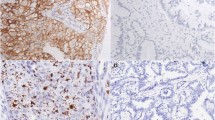Abstract
Nuclear atypia is one of the most important morphological features used to diagnose malignant neoplasms. The potential molecular alteration that causes nuclear atypia remains unknown. P53 and p16INK4A play crucial roles in cell cycle checkpoints and repairing DNA damage to maintain integrity of the genome. Thus, inactivation of p53 and p16INK4A has been hypothesized to alter the chromatin structure and result in nuclear atypia. This study examined 201 primary lung cancers for the immunohistochemical expression of p53 and p16INK4A, and analyzed potential associations with the essential elements of nuclear atypia, such as nuclear size, circularity of the outline, and the density and granularity of chromatin. Tumors that expressed high levels of p53 had larger nuclei with higher chromatin density and distorted nuclear outlines. Tumors that expressed low levels of p16INK4 had larger nuclei with distorted nuclear outlines. Thus, alterations in p53 and p16INK4A may be the potential cause of nuclear atypia in neoplastic cells.

Similar content being viewed by others
References
Kumar V, Cotran RS (1992) Basic pathology. In: Robbins SL (ed). W.B. Sounders Company, Philadelphia
D’Errico M, Calcagnile AS, Corona R, Fucci M, Annessi G et al (1997) p53 mutations and chromosome instability in basal cell carcinomas developed at an early or late age. Cancer Res 57:747–752
Dalton WB, Yu B, Yang VW (2010) p53 suppresses structural chromosome instability after mitotic arrest in human cells. Oncogene 29:1929–1940
Duensing A, Duensing S (2010) Centrosomes, polyploidy and cancer. Adv Exp Med Biol 676:93–103
Travis WD, Brambilla E, Muller-Hermelink HK, Harris CC (2004) Pathology and genetics—tumors of the lung, pleura, thymus and heart, IARC Press, Lyon. In: WHO (ed). IARC Press, Lyon
Okudela K, Woo T, Mitsui H, Yazawa T, Shimoyamada H et al (2010) Morphometric profiling of lung cancers-its association with clinicopathologic, biologic, and molecular genetic features. Am J Surg Pathol 34:243–255
Bodner SM, Minna JD, Jensen SM, D’Amico D, Carbone D et al (1992) Expression of mutant p53 proteins in lung cancer correlates with the class of p53 gene mutation. Oncogene 7:743–749
Shimamoto T, Ohyashiki JH, Hirano T, Kato H, Ohyashiki K (2004) Hypermethylation of E-cadherin gene is frequent and independent of p16INK4A methylation in non-small cell lung cancer: potential prognostic implication. Oncol Rep 12:389–395
McGee JO, Isaacson PG, Wright NA (1992) Principles of pathology. In: Wright NA (ed). Oxford University Press, Oxford
Alberts B, Bray D, Lewis J, Martin R, Roberts K, et al. (1994) Molecular Biology of the Cell. In: Watson JD (ed). Garland Publishing, New York
Thompson SL, Bakhoum SF, Compton DA (2010) Mechanisms of chromosomal instability. Curr Biol 20:R285–R295
Thompson SL, Compton DA (2010) Proliferation of aneuploid human cells is limited by a p53-dependent mechanism. J Cell Biol 188:369–381
Paolo D’Avino P (2009) How to scaffold the contractile ring for a safe cytokinesis—lessons from Anillin-related proteins. J Cell Sci 122:1071–1079
Li J, Wang J, Jiao H, Liao J, Xu X (2010) Cytokinesis and cancer: Polo loves ROCK‘n’ Rho(A). J Genet Genomics 37:159–172
Guasconi V, Souidi M, Ait-Si-Ali S (2005) Nuclear positioning, gene activity and cancer. Cancer Biol Ther 4:134–138
Cremer T, Cremer M, Dietzel S, Muller S, Solovei I et al (2006) Chromosome territories–a functional nuclear landscape. Curr Opin Cell Biol 18:307–316
Weichert W (2009) HDAC expression and clinical prognosis in human malignancies. Cancer Lett 280:168–176
Luczak MW, Jagodzinski PP (2006) The role of DNA methylation in cancer development. Folia Histochem Cytobiol 44:143–154
Au Yeung CL, Tsang WP, Tsang TY, Co NN, Yau PL et al (2010) HPV-16 E6 upregulation of DNMT1 through repression of tumor suppressor p53. Oncol Rep 24:1599–1604
Esteller M (2005) Aberrant DNA methylation as a cancer-inducing mechanism. Annu Rev Pharmacol Toxicol 45:629–656
Hobert JA, Eng C (2009) PTEN hamartoma tumor syndrome: an overview. Genet Med 11:687–694
Bunney TD, Katan M (2010) Phosphoinositide signalling in cancer: beyond PI3 K and PTEN. Nat Rev Cancer 10:342–352
Kondo M, Yokoyama T, Fukui T, Yoshioka H, Yokoi K et al (2005) Mutations of epidermal growth factor receptor of non-small cell lung cancer were associated with sensitivity to gefitinib in recurrence after surgery. Lung Cancer 50:385–391
Issa JP (2004) CpG island methylator phenotype in cancer. Nat Rev Cancer 4:988–993
Acknowledgments
This work was supported by the Japanese Ministry of Education, Culture, Sports, and Science (Tokyo Japan), and by a grant from Smoking Research foundation (Tokyo, Japan). We especially thank Emi HONDA and Misa OTARA (Kanagawa Prefectural Cardiovascular and Respiratory Center Hospital, Yokohama, Japan), and Hideaki MITSUI (Yokohama City University School of Medicine, Yokohama, Japan) for their assistance.
Author information
Authors and Affiliations
Corresponding author
Rights and permissions
About this article
Cite this article
Okudela, K. An association between nuclear morphology and immunohistochemical expression of p53 and p16INK4A in lung cancer cells. Med Mol Morphol 47, 130–136 (2014). https://doi.org/10.1007/s00795-013-0052-x
Received:
Accepted:
Published:
Issue Date:
DOI: https://doi.org/10.1007/s00795-013-0052-x




